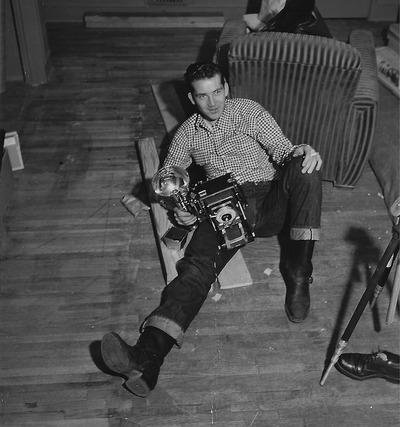By Drew Hardin

The young man on the floor, Speed Graphic camera in hand, is Robert E. Petersen, circa 1946–1947. Barely in his 20s, Petersen had returned to Los Angeles after serving in the Army Air Corps during World War II. He wanted to get his job back at MGM Studios, where he had worked in the publicity department. But with so many veterans looking to do the same, MGM couldn’t employ them all, and Petersen was caught up in a round of layoffs. He and another vet in the same situation, Robert Lindsay, decided to form their own PR agency, the Hollywood Publicity Associates. Among their first clients was the Southern California Timing Association.
Formed in 1937 to organize speed trials on Southern California’s dry lakes, the SCTA was facing a crisis: While their members were earnest young men and women in the quest for speed in organized competition, the media at the time were painting a lurid picture of the “Hot Rod Menace:” wheeled delinquents in souped-up jalopies wreaking havoc on public roads. In these newspaper accounts, hot rodders and hoodlums were synonymous terms. The SCTA needed a way to shift public opinion to something far more positive.
Association members came up with an idea to display their race cars in a show as a way to demonstrate that their motivations were far from the outlaw crowd the papers wrote about. They asked the HPA to promote the show, which would take place at the National Guard Armory in Los Angeles in January 1948.
Among the HPA’s tasks was the production of a show program, and Petersen took on the job of selling ads for the program. He called on the parts manufacturers and speed shops that made up the young speed-equipment industry, from Vic Edelbrock, Phil Weiand and Barney Navarro to Blair’s Auto Parts, Bell Auto Parts and SO-CAL Speed Shop. While getting to know those performance pioneers, Petersen saw an opportunity to promote this growing movement with a magazine. He knew cars—he had spent a lot of his youth helping his father, a mechanic for the Department of Water and Power—and he knew photography, thanks to Uncle Sam and his aerial reconnaissance photo training. His HPA partner Lindsay provided the publishing connections, as his father was the founder of the Tailwaggers dog club and produced the club’s magazine.
Petersen and Lindsay considered several titles for their publication, but decided to call it Hot Rod, despite the term’s negative meaning at the time. There was no use dancing around the topic, they felt. The magazine was about hot rods and hot rodding, so the title should be direct and to the point.
The first issue was published in January 1948. In their Editor’s Column, Petersen and Lindsay wrote that “Hot Rod is designed to inform and entertain those interested in automobiles whose engines and bodies have been rebuilt for better performance and appearance.” Those words have remained the guiding principle for Hot Rod editors, writers and photographers for 75 years.





